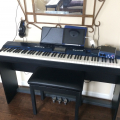Loopy Pro: Create music, your way.
What is Loopy Pro? — Loopy Pro is a powerful, flexible, and intuitive live looper, sampler, clip launcher and DAW for iPhone and iPad. At its core, it allows you to record and layer sounds in real-time to create complex musical arrangements. But it doesn’t stop there—Loopy Pro offers advanced tools to customize your workflow, build dynamic performance setups, and create a seamless connection between instruments, effects, and external gear.
Use it for live looping, sequencing, arranging, mixing, and much more. Whether you're a live performer, a producer, or just experimenting with sound, Loopy Pro helps you take control of your creative process.
Download on the App StoreLoopy Pro is your all-in-one musical toolkit. Try it for free today.
Piano Motifs driving PianoTeq Pro with 2 Layer Morphing
PianoTeq is a synth! It has effects, Morphing of 2 Layers, Envelope Controls and more.
It just takes the Pro level to get to the envelopes. They call it “Per Note” editing and everyone seems to think it’s not worth the money but I beg to differ.
I morphed the Steinway D and the E-Piano MK II Jazz presets and applied serious changes to the Attack Envelope and it’s no longer a piano:
WARNING: The Pianos come in HOT at 0:28 to 0:52. Be prepared.
I start with the Morphed Sound until 0:28 when the plain Steinway kick in.
The Rhode MKII is selected at 0:38 and the morphed instrument finishes from 0:52. HOT VOLUME HERE.
It’s a SYNTH! I’ll discover more madness and I recommend everyone try the DEMO Pro too to see
what you discover.
WARNING: The Pianos come in HOT at 0:28 to 0:52. Be prepared with volume control.



Comments
I don’t think people realize just how powerful pianoteq is. And the sounds are really nice!
Nice piece, curious to see where you go with Pteq.
BTW, Standard version has "per-note" editing of a few of the most useful parameters, including Attack Envelope. Pro allows editing of many more per-note parameters, but can't recall if there's more to do with envelopes.
Good to know. “Attack Envelope” makes a piano something else. I need to look into the “Overtone” controls and see if there’s gold in there for sound design. For my tastes, these are sound I love when synths can create them… like new acoustic designs:
bowed, played like rubbed glass bowls, hammer with very soft mallets, and similar to wind instruments…
Many synth mainstays like Glide/Portamento are missing unfortunately. But feeding these new sounds into AudioLayer can help flip back into synth style editing.
I could see making Decent Sampler packs from these edited creations and not feeling like I’m ripping off some IOS App maker.
This is a Pro level commitment and not protected “sample” IP. We pay to re-purpose these sounds. I’d be uncomfortable doing that with Demo mode.
I wonder whether something could be done with pitch wheel modulation to act like portamento. Would be a kludge, probably, and not very usable.
In any case, be aware that pitch bend in Pteq is polyphonic and can extend plus or minus 2 octaves from a base note. Very un-piano-like. To get this create/change the pitch bend action setting on Options, Midi page to +/- 2400 .
You could use with polyphonic aftertouch keyboard or midi automation and assign Aftertouch in midi event (first) slot to Pitch Wheel in midi action (second) slot.
Pteq is also MPE compatible, so you can use with MPE controller. In that case (I think) Pteq automatically configures if MPE controller is attached, can't remember, I think that's what happened when I connected my Linnstrument some months ago. With MPE each note will be separate channel, at least up to 15(?) note limit, and it seems like it would be possible to send different sustain pedal messages to each channel to get something approximating polyphonic control of release envelope. Maybe. Or you could roll-your-own MPE kind of thing with Polythemus or Mozaic and experiment similarly, without needing MPE controller.
I will investigate these MPE features and see if there’s something useful there. As far as Piano Apps go PianoTeq supports Sustain (CC64), Sostenuto (CC66), Soft(CC67), and Celeste (CC69). Using mfxConvert or a StreamByter/Mozaic script can convert Mod Wheel (CC1) or a PAD to use these extra features. Sustain is the most powerful in my opinion and it really tests the polyphony capabilities of any synth. This one seems to allow huge runs of notes with sustain on.